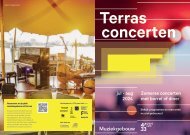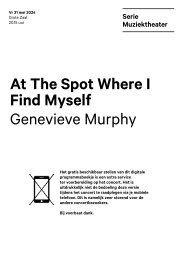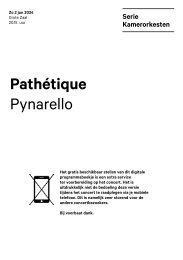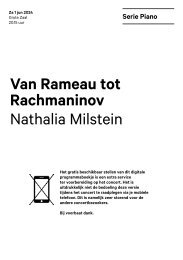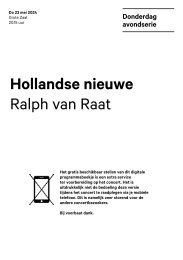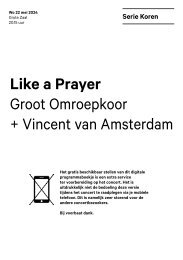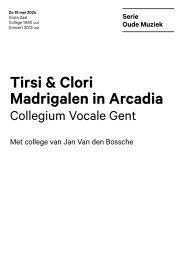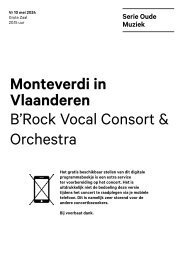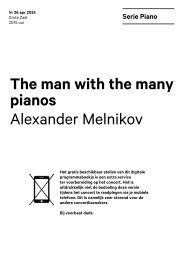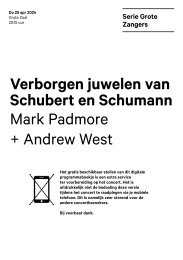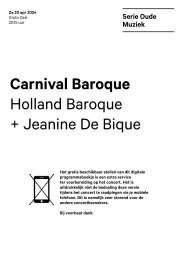You also want an ePaper? Increase the reach of your titles
YUMPU automatically turns print PDFs into web optimized ePapers that Google loves.
Programme notes<br />
Looking at the program of the <strong>Ragged</strong> <strong>Music</strong> <strong>Festival</strong>, it is easy to see that it relies on a<br />
multitude of connections, bridges, and associations. It is a complex network of pieces that<br />
may seem infinitely removed from one another but inexplicably reveal a relationship best<br />
described, perhaps, as resonance.<br />
Finding these connections and discovering<br />
the invisible links is a consuming, laborious,<br />
yet highly gratifying task. It is fascinating to<br />
witness this resonance awakening dormant<br />
forces, with one piece illuminating another<br />
in such a way that hidden meanings emerge<br />
and become apparent. This comes as close<br />
to a seance of magic as a musician can<br />
induce.<br />
This concert, which takes place exactly<br />
halfway through the festival, was conceived<br />
as a metaphor or a ritual celebrating such<br />
mutual illumination. It revives and relives<br />
the poignant dialogue between Johann<br />
Sebastian Bach and Dmitri Shostakovich<br />
through their Preludes and Fugues, a music<br />
form that is itself intrinsically dialogic in<br />
nature, in a way that has never been done<br />
before.<br />
Monument<br />
Bach’s double collection of preludes and<br />
fugues in every key, Das wohltemperierte<br />
Klavier, comprising two volumes of twentyfour<br />
and completed in the first half of the<br />
XVIII century, is revered by musicians as<br />
one of the greatest monuments of Western<br />
music. Though ironically introduced by<br />
Bach merely as a didactic and entertaining<br />
collection for musicians and amateurs (‘for<br />
the profit and use of musical youth desirous<br />
of learning, and especially for the pastime<br />
of those already skilled in this study’), it is<br />
truly a universe in its own right. The themes,<br />
emotions, and inventions found in these<br />
forty-eight pieces seem infinite, not to<br />
mention their formal beauty and perfection<br />
of Bach’s polyphonic technique.<br />
In turn, Shostakovich’s cycle of twenty-four<br />
preludes and fugues, written in 1950/51,<br />
serves as a direct response to Bach. Since<br />
the rediscovery of Bach in the XIX century,<br />
he has been a subject of ever-growing<br />
admiration, with many musicians paying<br />
tribute to him in one way or another.<br />
Shostakovich, in particular, was possibly the<br />
first major composer to openly ‘converse’<br />
with composers of the past through his<br />
work. His pieces, especially in the late<br />
period, are full of quotations and references<br />
(both direct or hidden, and sometimes even<br />
mock), from Bizet and Rossini to Wagner<br />
and Ustvolskaya. However, Shostakovich’s<br />
relationship with Bach seems more profound,<br />
respectful, intense, and ultimately, closer. In<br />
his cycle of preludes and fugues he doesn’t<br />
‘play’ with references, doesn’t ‘use’ Bach’s<br />
work to enrich his own. In a way, he does<br />
the contrary: entering the domain of Bach<br />
knowingly and respectfully while bringing in<br />
his very own sensibility and technique. There<br />
is no sense of rivalry or competitiveness<br />
here, nor interestingly, a sense of worship.<br />
Shostakovich’s cycle is distinctly his own -<br />
18





